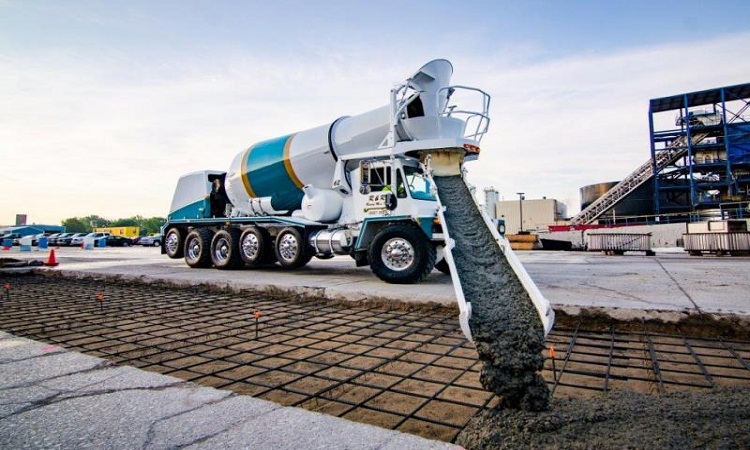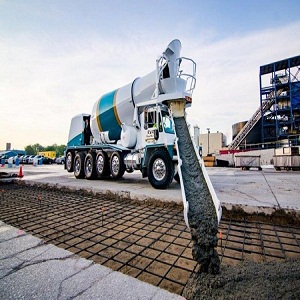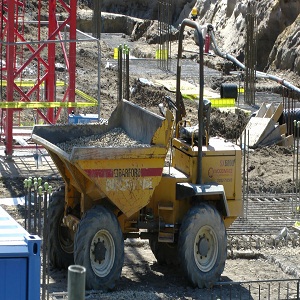Transportation of concrete is a significant activity in the production of concrete. The time taken in transit mixer should be a design parameter as it depends on the initial setting time of concrete as well as the requirement of workability at the placing point. The method of transportation adopted at the site should be decided in advance so that suitable admixtures can be decided.
Transportation of Concrete
- After the concrete or mortar materials have been batched and mixed, the concrete/mortar mix has to be transported and placed in formwork.
- Concrete transportation has to be done from the mixing point to the placing point in the shortest possible time so that it does not lose its workability. Care should also be taken that the mix does not segregate or bleed but remains a cohesive mass. Stiffening, bleeding, and segregation of concrete while transporting can result in loss of strength, non-uniformity, porosity, and poor durability. It is very important that the uniformity of concrete is maintained after mixing.
- In most of the projects in India, concrete and mortar are transported by a human chain by head loads. This method of transportation is slow and prone to errors.
- Delay in transportation can cause loss of workability and cohesiveness and thereby cause difficulty in placing and compacting the concrete.
- Cohesiveness and workability of the concrete mix should be adequate enough to cater to the mode or method and duration of transportation and placement.
- Transportation and placement specifications should be reviewed and necessary precautions for concreting at night or during periods of extreme heat, extreme cold, wind, or rain must be taken.
- Concrete is required to be transported in both horizontal and vertical directions.
Methods of Transportation of Concrete
The various prevalent methods of transportation of concrete given below:
- Mortar Pan
- Wheel Borrow or Hand Cart
- Bucket and Ropeway
- Truck Mixer and Dumper
- Belt Conveyor
- Chute
- Skip and Hoist
- Pump and Pipe-line Method
- Transit Mixer
Mode of Transportation of Concrete
The several modes of transportation of concrete can be broadly classified as:
Manual Mode of Transportation
In this case, care should be taken to see that proper walkways and staging are provided for workers to quickly, safely, and comfortably transport the concrete or mortar from the batching mixing point to the placing point.
Semi-Manual Mode of Transportation
The concrete or mortar mix is generally transported horizontally by manual means and vertically by mechanical means such as a builder’s hoist, crane, etc. care should be taken to give adequate slopes to the chutes required for unloading the material from the hoist onto the platform.
The following types of equipment are generally used:
- Transit mixers dumpers buggies etc. for horizontal transportation of the concrete mix.
- Conveyors, concrete pumps – these systems have a special advantage of transporting concrete both horizontally and vertically in one go.
- Crane and bucket – this equipment is suitable for high-rise structures.
- Helicopter – suitable for hilly and unapproachable areas and are used in developed countries for construction and transportation of concrete, men, and materials. Concrete is generally carried in a bucket that hangs below the helicopter.
Concrete Transported by Transit Mixers and by Dumpers
When concrete is produced from batching plant it is generally transported by transit mixers buggies or dumpers. Sufficient numbers of transit mixers are required at the site for larger concrete pours. When transit mixers are not available, concrete can be transported in small dumpers and buggies. The disadvantages of transporting concrete in dumpers or buggies are listed below:
- In the rain due to heavy showers, additional water may get mixed in the concrete while transporting and also after unloading on the platform at the site. While in a transit mixer, there are very few chances of rainwater getting mixed in concrete.
- In the case of transit mixers, a smaller quantity of concrete can be gradually unloaded on the platform, preventing loss of workability as the concrete is lifted manually and placed in position. In the case of dumpers or buggies the complete concrete load, if generally unloaded on a platform, will lose its workability by the time it is completely lifted and placed in the formwork.
- In transit mixer, concrete gets agitated continuously and hence does not segregate. The loss of workability is also slower due to continuous agitation. Whereas in dumpers agitating facility is not available and therefore loss of workability is faster and segregation can also occur thereby necessitating remixing of concrete before placing.
Checklist for Concrete Transportation
- If the concrete is transported by transit mixers, it is necessary to maintain revolutions within the prescribed limits (70 to 100 revolutions) at mixing speed. Any additional revolutions should be at an agitating speed only.
- It is advisable to keep water tanks empty and additional water and other ingredients preferably be done at the batching mixing plant only.
- Some specifications limit the time within which concrete must be placed. The addition of water to cater to a drop in workability due to delays in transportation is prohibited. Any addition in the concrete should be done and keeping the water to cement ratio of mix unchanged.
- During hot weather and/or strong winds concrete must be covered if transported in open containers. Similarly, the concrete during the monsoon period should be protected from water contamination.
- The concrete containers get coated with mortar during the loading, transporting, and unloading process. The coating must be removed and hosed off with a water jet. This is especially observed at the sharp corners.
- Contamination of concrete by oil, dirt, or windblown dust must be prevented.
- The container should be leakproof to prevent loss of mortar or cement slurry during transportation. Baskets to carry concrete by heal loads should not be permitted.
- Concrete transported through long distances may segregate due to vibrations, incorrect use of chutes, placers, pipelines, or dumps due to rough road surfaces, etc.
- If the concrete mix is not transported quickly enough, so there will be a drop in workability and the mix stiffens. If such delays are anticipated then the mix should be designed with higher workability or using workability retention admixtures.
Concrete Transportation for Massive Structure
Concrete production and transportation in warm/hot weather should be done as quickly as possible, so that concrete reaches the placing point without much loss of workability. This helps in the reduction of thermal stresses due to the reduction of the temperature differential between temperatures within the mass and the surface.
The concrete transportation should be done by mechanical means as far as possible, as the large quantity of the concrete has to be transported in as short a time as possible. For concrete placing in the dam, ropeways with large buckets are generally used for the transportation of stiff mix.
The concrete transportation for placing concrete in massive reinforced concrete foundations is best done using transit mixers and concrete pumps. However, concrete in our country is generally transported by manual means. The requires large mobilization of manpower, much better control and supervision than mechanical transporting and placing. Manual transportation of concrete will also need greater safety precautions, greater mobilization of staging and walkways. However, considering the present availability of suitable equipment and difficulty in mobilizing and controlling a large workforce, manual transporting and placing of concrete is not recommended.
The transporting equipment should be in good working condition to ensure trouble-free continuous concrete supply from the batching/mixing point to the placing point. Concrete equipment such as pumps, transit mixers is generally capable of performing continuously for a considerable large period without any problem or stoppage.
Concrete Transportation for Slender Structures
Concrete should be transported from batching/mixing point to the placing point such that there is minimum loss of workability in slender sections, this is most essential to get good consolidation.
It is often observed that in slender sections, concrete is not placed and compacted properly. This results in a poor and weak surface finish, which in turn results in inadequate protection to steel. The steel rusts in presence of moisture and oxygen as the concrete around it are porous. Rusting disintegrates concrete and results in spalling of concrete and subsequently ends up in costly repairs or a structural failure.



